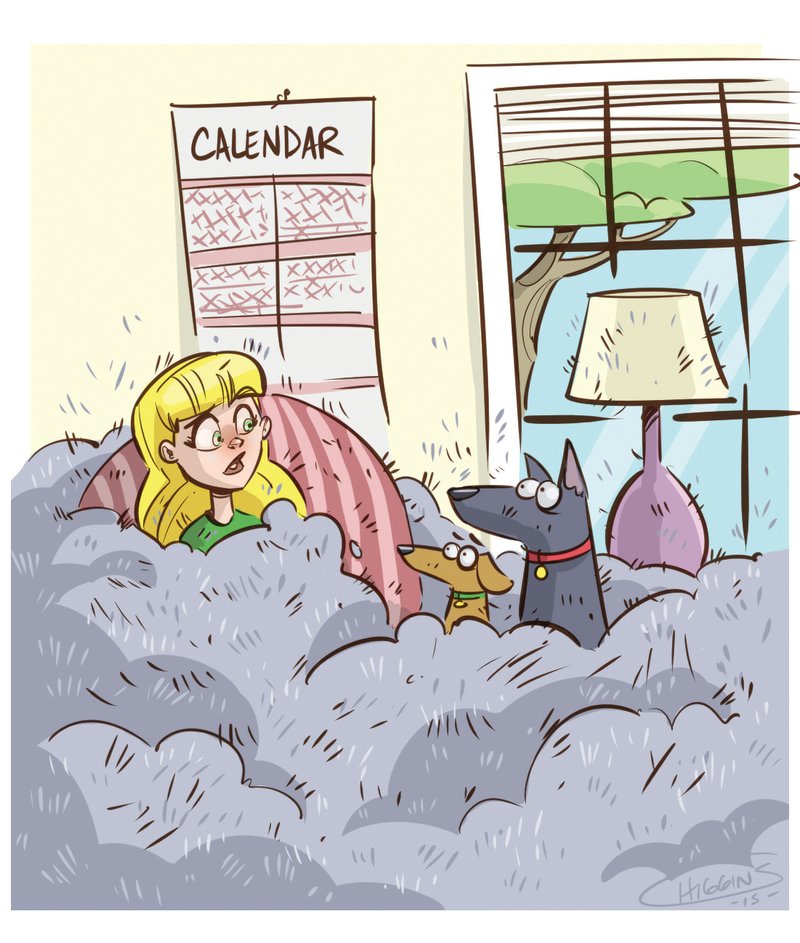Help! My dogs are shedding all over the place. Both dogs were adopted from shelters and are mixed breeds. One looks like he's part German shepherd. He has what's called a double coat. The other one is short-haired and small, sort of like a beagle. We call him our "beaglet." Both shed some all year, but our shepherd-mix dog's hair comes out in tufts in the spring. I know we can't stop the shedding, but any advice is welcome.
Pollen isn't the only thing that's blowing in the wind and sticking to everything at this time of year. While most dogs drop a bit of hair year-round, dogs with double coats --a coarse outer hair and softer inner layer of fur-- molt or "blow" their coats a couple of times of year when the weather changes.
German shepherds are among the breeds with double coats, so if your mixed breed has fur like a shepherd, he's most likely in the throes of seasonal shedding. While there's no stopping the fur from flying while the molt occurs, you can take steps to avoid drifts of hair amassing along your baseboards. The simplest approach is to brush your dog daily to remove loose hair, veterinarian Betsy Brevitz says in Hound Health Handbook. While your pooch is in full molt mode, you may want to brush him outside. Remember to stand upwind or you could find yourself with a faceful of fur.
During the heavy shedding period, brush both dogs daily and bathe as often as once a week with a mild dog shampoo. Before you begin the grooming routine, however, make sure you have the appropriate grooming tools for each pup. A groomer or veterinarian should be able to suggest brushes and combs that are best for your dogs.
For a double-coat dog, drsfostersmith.com recommends tools such as an undercoat shedding rake or a shedding blade. Both tools grab and remove the loose lower layer of hair. This type of tool should be used only on dogs with two layers of fur. If your smaller dog is truly a beagle mix, he may also have a double coat. Beagles typically have a fine undercoat and short, hard top layer of fur. They shed the most in the spring, although not as dramatically as a dog with a German shepherd type of coat.
As well as brushing daily, also brush the dog before bathing to remove as much hair as possible. Brush again as the dog is drying to remove the hair loosened during bathing.
Daily brushing may seem time-consuming and labor-intensive, but look upon it as premium bonding time with your dog. Talk to the dog and stroke him as you brush to make sure he stays calm and happy. Never tug the brush through the coat or try to muscle through tangles -- there's no gain in pain or discomfort. After brushing, let your dog play with his favorite toy, take him for a walk or reward him with a special food treat.
A couple of other thoughts about shedding:
• Some people believe that premium dog foods or those fortified with antioxidants and essential fatty acids can reduce shedding, but Brevitz says that's not the case. While those foods may be nutritionally balanced, they most likely would simply make the hair floating throughout your house extra glossy.
• If your dog's hair loss is excessive, he may need to be seen by a veterinarian. Signs that shedding is more than a seasonal blow-out include dry, scaly or scabby skin. Another sign is patches of bald skin that appear red or irritated.
• Keep "sticky rollers" -- rolls of double-sided tape used to remove lint and pet hair from clothing and upholstery -- in handy places throughout the house and even in the car during shedding season. Actually, they're useful year-round, especially when living with pets. You can also get washable sticky rollers that can be rinsed in warm water and reused indefinitely. The down side with these is that the hair washed off the rollers will go down the drain, creating the potential for clogs, unless you use a trap to catch it.
Family on 04/29/2015

